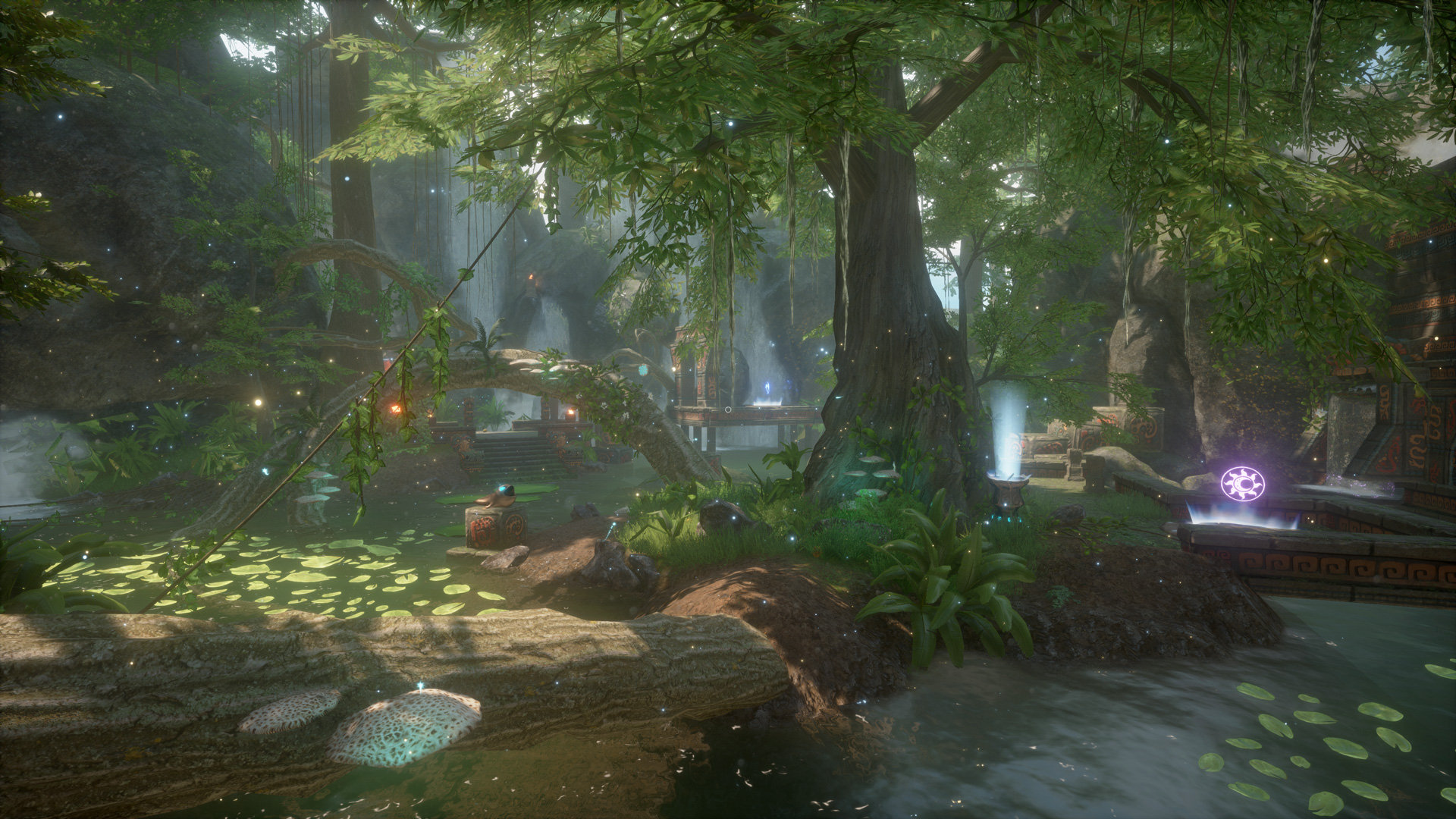
XING: The Land Beyond launched for PC audiences less than a couple years ago, and though it wasn’t the most high profile of releases, it immediately caught the attention of all those who played it, receiving praise for its immersive and serene environments, beautiful art style, puzzle design, and VR capabilities. Earlier last month, the game came out on PS4 as well, with the promise of all that, on top of added content, and of course, PS VR support. Recently, we sent across some of our questions about the game, its PS4 launch, and a lot more to its development team. The following questions were answered by co-developers Koriel Kruer and John Torkington.
"As VR grew and changed, with new technologies and options coming out, we wanted to be able to support those options to make sure people could have a comfortable experience playing the way they wanted."
What can players expect from the PS4-exclusive level in Xing?
Koriel Kruer: Lava! And also a new short story with a few new puzzles, including a new game mechanic that uses rain with the lava. The environment is very different from any others in XING so far, with an active volcano that can seen nearby and large nordic stone ruins covering the grounds.
Do you have plans for any more content that you’re looking to add to Xing– perhaps as DLC?
John Torkington: So far, there is nothing else planned for DLC. It honestly depends on how well the game does on PS4 and PS VR.
One of the things that a lot of players appreciate about Xing is the fact that it offers more than just one movement option, which is an even bigger bonus for a VR title. Was that something you were aware of, and wanted to add to the game from the very beginning of development, or was it a decision you came to later on?
Koriel Kruer: Having multiple play options was something that was important to us from almost the beginning of the project, starting off with basic WASD + mouse or controller playing it flat. As VR grew and changed, with new technologies and options coming out, we wanted to be able to support those options to make sure people could have a comfortable experience playing the way they wanted.
Xing has a very unique and immersive method of storytelling- can you talk to us about it was conceptualized, and how hard it was to implement it in the game?
Koriel Kruer: We tried a variety of ways to implement the narrative, including passive and active ways for the player to “get” it. In the end we went for an “active” way, in which players need to interact with the tablets and pick them in order to read or hear the words that are written. This doubles as a collectible, making it so that people who are not as into narratives but are collectors in games would also benefit from this mechanic.
We wanted to encourage players to get the narrative as much as possible by giving out bonus runes for collecting all the tablets, but at the same time didn’t want to make it mandatory for those players who didn’t care and only wanted to play for the puzzles. It was a fun balance. Even after we came up with the collectible tablet idea, it still took a while for us to also decide to include voiceover for each character, which we determined would give them a stronger personality and a more “human” quality. Other parts of the narrative in XING are all writings scattered around, such as the wall tablets on the main hub area of Zeneth which translate from Runes to English as you collect more bonus runes. Those tell the overarching story.
There are also the Muses, the little “bird baths” scattered around all the levels that contain hints, insights into stories and some fun references to our favorite media. Those are simply activated by walking near them, which gives another type of interaction with the environment for players. The designs themselves for each of these narrative conduits took us time to come up with, mainly through trial and error, but we are happy with how they turned out in the end.
Xing’s visuals have been praised quite a bit since its launch, especially so because it manages to retain its impressive look even in VR- how much of a challenge – and how much of a focus – was it for you to get that right?
John Torkington: Fidelity in VR was a huge concern of ours from the start. Well before we had begun work on the PS4 and PS VR version we found out the rendering challenges of VR, and the amount of work we had ahead of ourselves to get our vision to run smoothly in the new paradigm. Fortunately over the years significant progress has been made in the VR industry as a whole to help us realize our goal, but we still spend many months tweaking settings and art styles to find a happy medium between realism and expressionism – something that would read well on a monitor / TV and in VR.
How much do you feel VR adds to the experience? Is there a significant gulf in the experience without VR?
Koriel Kruer: Most people who have played the game in VR have said they prefer it and recommend it that way, as it adds so much to the immersion in the experience. Personally I enjoy both ways, as there are pros and cons to each. A Pro for VR is that it is highly immersive and a unique experience, but a Con for VR would be that it shows with lower quality graphics (as compared to the graphics at max settings on a flat screen). It really depends on personal preference. We spent a lot of time trying to make the experience great for both modes of play, so whether or not someone owns a VR headset, it should be a great experience.
Do you have any plans to launch on any other platforms?
John Torkington: We’ll be watching the reception of the PS4 and PS VR version of the game to use as a metric for interest in other platforms.
"VR opens up a lot of new doors for game design and player experience. Feeling like you are in a game world rather than just looking at it on a screen is already an incredible experience, and we can see that type of experience being used in many ways. We see VR being used for much more than just games."
Motion sickness is a potential pitfall that VR games have always had to contend with- was that something that you were mindful of in particular during development?
Koriel Kruer: Oh yes! Sim Sickness was always part of any conversation we had about movement and comfortability in the game. We took it into consideration for everything from movement to camera control to color and light.
VR has been growing as a medium and showing an increasing amount of potential, but in your view, what sort of experiences can push it even further? Have there been any recent examples that have stood out to you?
Koriel Kruer: VR opens up a lot of new doors for game design and player experience. Feeling like you are in a game world rather than just looking at it on a screen is already an incredible experience, and we can see that type of experience being used in many ways. We see VR being used for much more than just games.
We believe VR will be used for all types of industries, such as education, home design, or travel. Ideally, in education, a history teacher will be able to bring their class into an ancient Greek democratic assembly, a biology teacher will be able to show their students up-close representations or 3-D videos of animals in their natural habitats, and a science teacher will be able to show off our galaxy to students by giving them a view from space. Home designers, architects and engineers will be able to show clients how a room or building will look before it’s even built, and clients will be able to walk around in those spaces before they make the commitment to any purchases. Digital sculptors and 3D modellers will thrive in new businesses as well as businesses that have no need for such work now, creating new products and prototypes via virtual tool sets, building out technical models for running simulations, and selling models through portals for people who want to add waterfalls or giant elephant statues to their virtual homes. We can imagine simple VR HMDs being a normal part of tons of businesses, and people in the future will wonder how we ever got anything done without it.
We think VR will also have a role in long-distance communication and social media too. People who travel on vacations or who area away from their loved ones for a period of time will have a more intimate way of communicating and enjoying each-other’s company over that distance. A mom will be able to talk to her kids in VR, and walk them along a virtual beach. Long-distance lovers will lay in their beds with their headsets on and look at each other, talking about their days. Friends who want to stay in touch after they go off to college will be able to meet up in a virtual space and go flying around a virtual forest together. People looking for love online will be able to have virtual dates at the movies or playing games, before committing to seeing that person in real life. In some ways it will be a scary change, and in other ways it will be much more convenient.
As for the gaming industry, VR has already changed it quite a bit. We believe that VR will continue to encourage innovative game design, from types of locomotion, to variations on hand-controls, to the way players interact with a game world. Changes in software and hardware have already progressed towards creating better VR experiences. We’ve seen and tried lots of new peripheral products that have popped up over the past 5 years, including 360 treadmills, tactile gloves, adapters that attach to a Vive to make it work wirelessly, and vests that make you feel like you got hit in a game. Though 360 treadmills aren’t really viable for the average gamer these days, moving those types of larger peripherals to arcades has been the right call. Ultimately, the more creativity that happens in the VR space, the more options we all have moving forward.
Will the game will feature PS4 Pro specific enhancements? What can players expect if they are playing the game on PS4 Pro? Is 4K/60fps on the cards?
John Torkington: The game fully supports the PS4 Pro. We offer two graphics settings on the pro: High Framerate has the game running at 1080p at locked 60fps, with very high shadow and detail settings. High Quality set the resolution at I think 1600p and locks the framerate to 30hz. We did some tests at 4k, but we think the 1600p setting looks really nice while still maintaining framerate and detail settings. PS4 Pro also enhances PS VR, running at a much higher internal resolution and super samples for extra clarity in VR.
How is the game running on the original PS4, frame rate and resolution wise?
John Torkington: On a television running on an original PS4, XING has two graphics options. The High Framerate setting nets you ~50 – 60 fps unlocked at full 1080p, with shadow and detail settings set to medium quality. The High Quality setting locks the framerate at 30hz at 1080p, but pushes the quality settings higher. On PS VR, there is a resolution hit compared to the Pro, but we’ve done our best to push the system as hard to produce a clean image.
"We believe that VR will continue to encourage innovative game design, from types of locomotion, to variations on hand-controls, to the way players interact with a game world."
Next gen is coming sooner or later. From a development perspective, what is your biggest expectation from PS5 and Xbox Scarlett?
John Torkington: I’m mostly curious about Microsoft and Sony’s commitment to backwards compatibility. With both players moving away from purpose build hardware and onto the x86 platform, as well as them both making a “big boy” version of their original console this generation, I think we’ll see a more PC like incremental upgrade with the next generation. We’ll see if Microsoft pushes VR for Xbox, and if Sony continues with the current PS VR or makes a new one.
Do you think cross platform will be one of the defining features of next-gen consoles?
John Torkington: Barring technical challenges that I’m frankly not familiar with, cross platform play seems like a total no brainer. Admittedly I’m very consumer focused, and therefore generally support any features or movements that simply give the end user more in the end. I play Rocket League a fair bit, and being able to play with my PlayStation brethren on my PC is fantastic.
What is your take on the ongoing drama of loot boxes and microtransactions?
John Torkington: I think it is an amazing study on human behavior. I’m not 100% against having microtransactions in games, especially when implemented well, but when they start becoming a focus or manipulating the fundamental gameplay of a title they become a huge problem.
Do you think Microsoft is missing out on VR opportunity, specially given how powerful the Xbox One X is?
John Torkington: I mentioned my interest in Xbox VR earlier, but I trust Microsoft is simply playing a waiting game. Current gen VR really is first gen, and despite Facebook, Valve, and Sony’s efforts, there are still a lot of technical challenges to overcome. I imagine Microsoft’s engineers are taking a good look at the current offering and researching how to do it better. I hope they come up with something great, and in turn inspire the other companies to compete!
Do you think VR is something that will become an integral part of how we play our games any time for PS5 and Xbox Scarlett?
John Torkington: I think we’ll continue to see a split for VR and non VR titles, at least until VR had the fidelity to compete with a television. I do think VR will play a bigger role in the next generation, especially because (presumably) it will be around at the beginning, not halfway through. A VR solution may sway consumers one way or another.

















